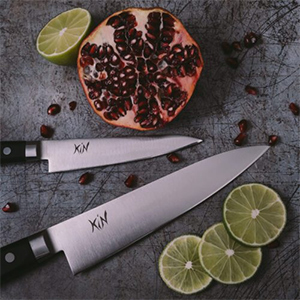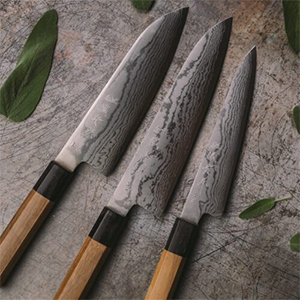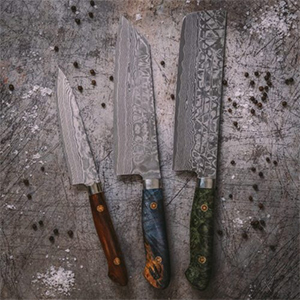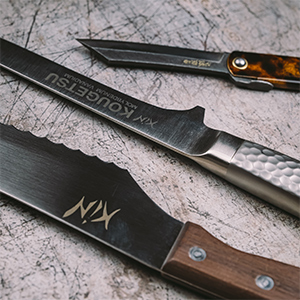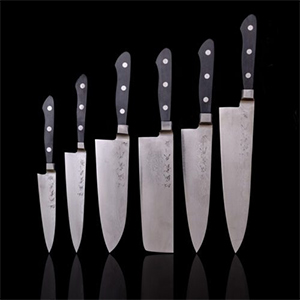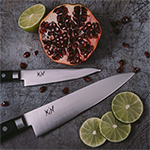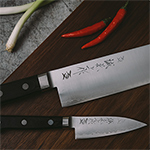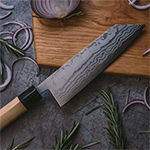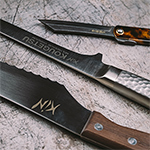Sharpening your knife on a…
… Horl sharpener
Using the Horl sharpener is extremely easy. It does not require soaking and allows you to execute the perfect angle every time. The Horl sharpener is only suitable for double bevel knives that are sharpened equally on both sides of the blade – these can be sharpened to 15° or 20° degree angles. The 15 degree side is for Japanese knives and the 20 degree side is for western knives. Each sharpener comes with a diamond grinding disc and a ceramic honing disc (the premium sharpening set is also available at an extra cost, which includes interchangeable #3000 and #6000 discs with a leather finishing strop. The higher grit discs will provide a more refined finish and a wipe over the leather strop will remove any shaprening residue). The HORL 2 comprises of two parts: a magnetic angle support bar and a roller – which houses the discs. To use the Horl sharpener, the knife is placed upside down against the support bar and held in place by strong magnets, the disc roller is then rolled up and down the length of the blade. For smaller knives, simply place the knife higher on the support bar so the sharp edge of the knife will always be touched by the roller. For deeper knives you will need to rest the knife and magnetic support bar on a work surface, then raise the roller up by placing it on top of a thin chopping board until the roller is in contact with the entire edge when sharpening. Care – keep both the sharpener and the angle support dry. You can clean the diamond grinding disc with an eraser to remove dust. For larger deposits, soak the surfaces in hot water with dishwaser liquid and gently remove with a brush. The diamond steel disc will become less coarse after approximately 20 uses; this is intentional, and will still function as intended for subsequent uses.
… whetstone or diamond stone
Depending on the sharpening stone you are using, you will either need to soak or apply water to your stone. Waterstones need to be soaked for approxiamtely 20-30 minutes by submerging them in water prior to use to ensure they are soft enough. When air bubbles stop coming out of the stones, this indicates they are ready for use. For diamond stones you need to apply a generous splash of water to the stone prior to use. Remember to keep the stones lubricated with water throughout the sharpening process and dry them thoroughly after use. It is best to sharpen your knives on a non slip mat if possible with the stone laying lengthways away from you for safety reasons.
Sharpening double bevel knives
Most knives sold by Kin Knives are double bevel knives – meaning they are sharpened equally on both sides of the blade. Start with the tip of the blade at the bottom of the stone (nearest you) at an angle of 15° and push the knife forwards, away from you at the same time as moving the knife across the stone. The aim is to cover the entire length of the blade in the same stroke and utilising the whole length of the stone. Remember to keep the angle the same throughout by using the second handle to keep equal pressure as you move the knife. You will need to move the handle up towards towards the top of the stone as you reach the end of the knife to follow the curve of the the blade. Take your time and do this slowly to ensure a nice even light pressure is maintained. This movement will result in the heel of the knife (nearest the handle) ending up at the top end of the stone. This process is then reversed. You simply turn the knife over, keeping the heel near the top end of the stone and draw the knife across and down the stone. This motion will result in the tip of the knife ending up in the starting position at the bottom of the stone. Repeat equally on both sides of the knife. There are a few additional ways you can sharpen on a whetstone; you can start with either the sharp edge of the knife facing towards you or away from you and then if you are confident, it gets a good edge going both ways in a continuous motion (you can go back and forth on one side of the knife and then turn it over to go back and forth on the other). Do what feels right for you, as long as you are covering the length of the blade in the same stroke and keeping the angle the same as you move you will be fine! Test the knife is sharp by slicing tomatoes, others like to test on paper; either way continue sharpening until the knife is Kin sharp! You may feel more comfortable to sharpen the knife in sections which is not a problem either.
Sharpening single bevel knives
A few knives that we sell, such as our Deba and Yanagiba knives are single bevel – meaning they are hollow ground and flat on one side, and have a large bevel on the other. Sharpening these knives is very different to sharpening double bevel knives. After soaking and preparing your stone you will see the large bevel on one side of the knife; place this side down on to the stone so that only the bevel is in contact with the stone. You can sharpen this bevel in sections as you work your way along the blade from heel to tip. You simply keep that bevel in contact with the stone and rub up and down the stone ensuring equal pressure throughout. After a few wipes you will be able to feel a small ridge (or burr) forming on the flat side of the knife. Once this burr has formed all the way along the blade, it is now time to remove the burr. You will need to flip the knife over and lay the flat (or hollow ground) side down on to the stone. Again, in sections, keep the blade flat but rub the knife up and down the stone to remove the burr. Finally you will need to sharpen the micro bevel, the “koba”. To do this you will need to lay the large bevel flat on the stone again and then tilt the blade up to 15°. You can do this by imagining or placing a pound coin under the blade at the top of the larger bevel. Then, after removing the coin, you can either sharpen in sections or in light continuous strokes to sharpen that micro bevel. You can finish with 4 – 6 wipes with the flat side down on the stone again.

